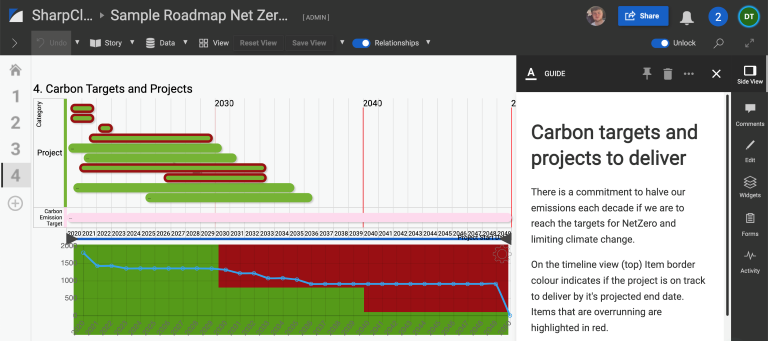Businesses are becoming climate leaders. By undertaking a low carbon transformation and pursing carbon neutrality, we demonstrate a willingness to act against the problem of climate change. The Earth is warming – organizations have a responsibility as role models to conduct sustainable business and to play their part.
But what does it mean to be carbon neutral? And why are organizations embarking on this journey at all? Between a wider understanding of the world your business operates in, and building a roadmap for modifying your business infrastructure, there’s a lot to know.
What is the issue with climate change?
Before looking at carbon neutrality, it’s important to underline the issue of climate change. The Earth’s temperature is rising. This is being caused by the greenhouse effect, which is when the atmosphere traps some of the Sun’s energy. This energy is absorbed by gases on Earth and dispersed again, with some being trapped by carbon dioxide in the atmosphere.
Increased human activity has meant more energy being trapped by CO2, increasing the number of emissions in the Earth’s atmosphere, which is heating the planet.
Achieving carbon neutrality is when a company has balanced its carbon emissions with funding an equivalent amount of carbon savings elsewhere. Everyone and everything has a carbon footprint – managing the impact of yours is crucial on the journey to becoming carbon neutral.
What is Carbon Neutrality?
Carbon Neutrality is having a balance between your organization's input and output with greenhouse gases - with your 'input' being what you do to reduce greenhouse gases, and 'output' being what actions you are taking that release greenhouse gases.
In other words, it's the idea of helping reduce greenhouse gases, to a level where it's equal to (or higher than) the greenhouse gases your organization is producing.
Why pursue carbon neutrality?
Taking action on climate change and pursuing carbon neutrality is critical to the long-term success of organizations, allowing them to:
- Increase revenue
- Engage customers and stakeholders
- Mitigate future risks
- Reduce costs
As well as being essential to stopping global warming, having a carbon neutral goal can help improve business performance. By encouraging a climate-conscious workplace, your business reduces costs and saves money through energy efficiency. Self-generated sustainable energy helps drive down your energy bills and communicating carbon neutral best practices internally helps staff understand their own footprints.
Sustainability is also a very marketable angle for your business. Customers want to make a difference to their own carbon footprint and are choosing to buy from climate-conscious organizations. Having a carbon neutral goal helps engage both your customers and your stakeholders, proving you have a long-term vision for your company and helping to improve your reputation.
Considerations and tips for going neutral
Going carbon neutral doesn’t happen overnight. As a business, there are considerations that need to be made when preparing your journey.
Keep track of your goal
When outlining your plan to become carbon neutral, setting a target date helps to establish your business’ stake in achieving that goal. The EU aims to be carbon neutral by 2050 and many organizations are building roadmaps to try and meet that deadline. Epson have matched this deadline and want to be carbon neutral by 2050.
With such a lengthy period of time allowed, how are they tracking their progress? A dynamic roadmapping software could help them not only communicate progress internally with stakeholders and c-suite executives, but also with customers externally.

Smaller companies can pursue neutrality too
The process of pursuing carbon neutrality and having a carbon neutral goal is the same, regardless of business size. Smaller companies do face difficulties however – a lack of capacity means fewer resources at their disposal, and not owning their own building means they have limited control over the changes that can be made.
See how to prioritize your strategic goal of Carbon Neutrality
This makes resource management and allocation all the more important. Smaller companies need to understand the impact carbon-neutral choices have on their bottom line, making visibility a key consideration.
Achieving carbon neutrality has immediate advantages
Attempting to become carbon neutral is a vital opportunity for any company to scrutinize where its power comes from. It’s a chance to switch to renewable energy sources and reduce both energy usage and cost. This creates brand new value for the company while helping them gain a greater understanding of their supply chains.
There will be unavoidable emissions
When attempting to pursue carbon neutrality, some emissions are unavoidable. Luckily, being carbon neutral doesn’t mean stripping your organization of all of its emissions, just seeing the ways you can offset your carbon effectively. Emissions associated with air travel, construction, and shipping, are all often unavoidable.
But once a company knows its carbon footprint, it can begin to work to offset it. The Biden administration wants to support regenerative practices as part of a plan to cut greenhouse gas emissions from agriculture and other industries. Particularly in agriculture, where 10 to 14% of all global emissions are created, there are plans for a ‘carbon market’, where farmers will be paid for the carbon they capture in their soil.
Customers will reward your business
Choosing to pursue carbon neutrality sends a message, and customers are listening. Sales of consumer products marketed as sustainable grew upwards of seven times more quickly than those that weren’t between 2015 and 2019.
Become climate neutral certified is a simple way of communicating the values of your business, and where you stand. Customers are more eco-aware than ever before, and many want to buy from responsible, sustainable companies. Organizations that commit to sustainability may find themselves attracting clients they never had before.
These benefits extend beyond customers. It’s possible to engage stakeholders by demonstrating to them that you’re making a difference within your business, and in doing so, motivate staff to stay and be proud of the business they’re a part of.
See how to Engage Stakeholders in SharpCloud
Using roadmaps to pursue carbon neutrality
Roadmapping software is used to help organizations understand and align their long-term business goals. By building a viable roadmap demonstrating your carbon neutral goal, you can then think about a systematic approach to achieving it.
SharpCloud's dynamic software is a modern roadmapping and business alignment tool that offers real-time changes, meaning you don't waste any time or decisions, when communicating your carbon neutral plan to stakeholders and c-suite executives.
If you're setting a goal of becoming carbon neutral by 2050, a visually compelling roadmap frees your plans from static, lifeless presentations, while enabling you to manage your vision from a single tool.

